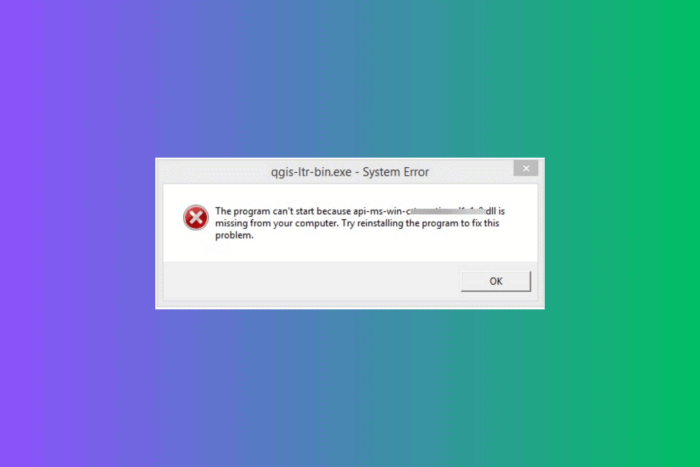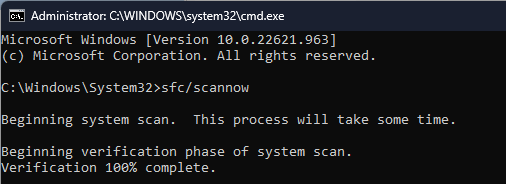6 Ways to Fix the Guard64.dll Not Found Error
Reinstalling the affected app can resolve the issue
4 min. read
Published on
Read our disclosure page to find out how can you help Windows Report sustain the editorial team. Read more

If you encounter the Guard64.dll not found error while launching the COMODO Internet Security app, it could be caused by a conflicting driver, corrupted system files, or an accidentally deleted DLL file.
Guard64.dll is a Dynamic Link Library file associated with COMODO Internet Security. To begin with, check if any Windows updates are pending, head to the Recycle Bin to ensure the file is not deleted by mistake, and run a malware scan using a reliable third-party antivirus tool.
How can I fix the Guard64.dll not found error?
1. Reinstall the affected app
- Press Windows + I to open the Settings app.
- Go to Apps, then select Installed apps.
- Locate COMODO Internet Security, click the three-dot icon, and select the Uninstall option from the context menu.
- Click Uninstall again to confirm.
- To reinstall the app, go to the official website, download the latest version and install it.
2. Get the DLL file fixer tool
If you have another Windows device with the same version, locate the DLL file from C:\Windows\System32\guard64.dll, and paste it into the affected device at the same location.
However, if you are unsure of this method, we recommend you using a third-party DLL fixer tool. Once you decide on the one you prefer, all you need to do is download & install the tool and then run it to fix the DLL-related issues.
3. Reregister the DLL file
- Press the Windows key, type cmd in the search box, and click Run as administrator from the list of options to launch Command Prompt with administrative privileges.
- To re-register the Guard64.dll, then type the following command and press Enter:
regsvr32 Guard64.dll - Click OK when prompted and reboot your computer to save the changes.
Before you follow these steps, go to C:\Windows\System32 and look for Guard64.dll and if it is present, follow the steps above to reregister the file.
4. Run SFC & DISM scans
- Press the Windows key, type cmd in the search box, and click Run as administrator from the list of options to launch Command Prompt with administrative privileges.
- Copy & paste the following command to repair or restore the damaged system files on your computer, and hit Enter:
sfc /scannow - Let the scan be executed, type the following command to scan the Windows image for corruption and repair it via Windows Update, and press Enter:
Dism /Online /Cleanup-Image /RestoreHealth - Wait for the scan to complete, and restart your PC to let the changes take effect.
5. Restore your system settings to an older version
- Press Windows + R to open the Run dialog box.
- Type rstrui and click OK to open the System Restore wizard.
- Select Choose a different restore point in the System Restore window and click Next.
- From the list of restore points, select the one that was created before you encountered the Guard64.dll not found error, then click Next.
- Click Finish to initiate the process.
Windows will reboot and try restoring the system settings to the selected point. However, after restarting, if you see the System Restore is not working message, it could be due to a conflicting driver or corrupted system files; we have a detailed guide for you.
6. Download the DLL file manually
 NOTE
NOTE
- Visit the DLL-ME website link to open the Guard64.dll page, then click Download next to the version suitable for your computer.
- Once downloaded, double-click the folder to open it, then copy the DLL file.
- Navigate to this path and paste the DLL file after replacing C with the system drive letter if it is not C for you:
C:\Windows\System32 - Restart your computer to save the changes.
In conclusion, to fix the Guard64.dll not found error, you can repair the system files using SFC & DISM scans, reinstall the affected app, re-register the DLL file if it is already present on your device, or use a DLL fixer tool.
If you often see errors or pop-up messages related to missing DLL files; then, don’t forget to read this guide to learn the reasons for preventing them.
Do you face the same issue due to any other DLL file on your computer? Check out the common ways to restore the DLL file quickly.
Before you go, check out our latest guide on what to do if you see coIEPlg.dll is missing error on your computer.
Did we miss a step that helped you fix this DLL missing error? If so, share the method in the comments section below, and we will add it to the list.


















User forum
0 messages